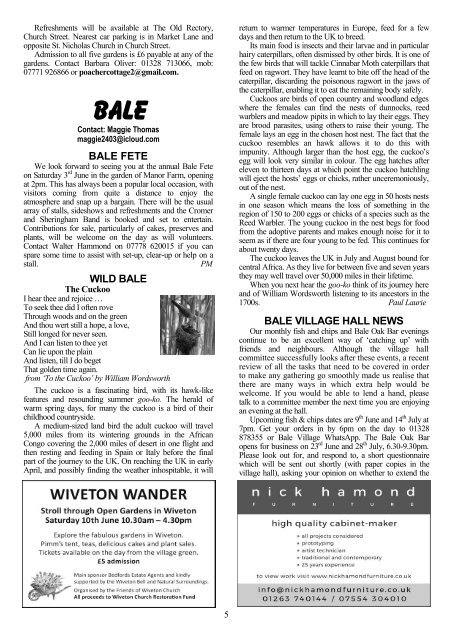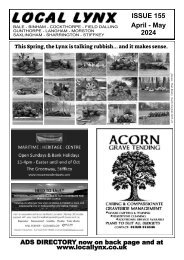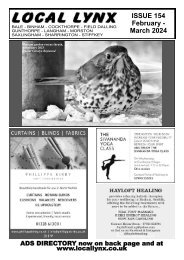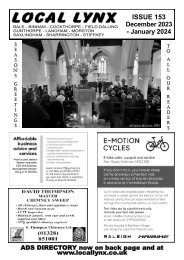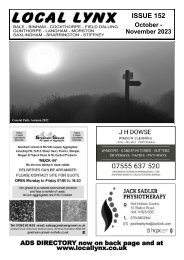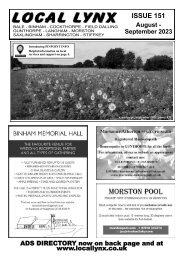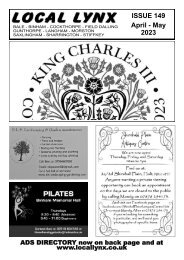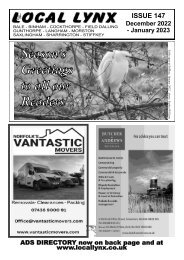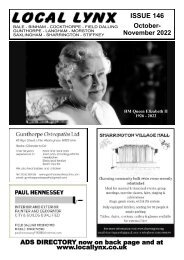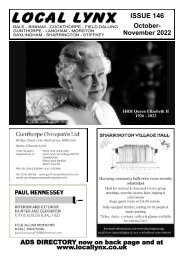Local Lynx No. 150 - June/July 2023
The community newspaper for 10 North Norfolk villages
The community newspaper for 10 North Norfolk villages
You also want an ePaper? Increase the reach of your titles
YUMPU automatically turns print PDFs into web optimized ePapers that Google loves.
Refreshments will be available at The Old Rectory,<br />
Church Street. Nearest car parking is in Market Lane and<br />
opposite St. Nicholas Church in Church Street.<br />
Admission to all five gardens is £6 payable at any of the<br />
gardens. Contact Barbara Oliver: 01328 713066, mob:<br />
07771 926866 or poachercottage2@gmail.com.<br />
BALE<br />
Contact: Maggie Thomas<br />
maggie2403@icloud.com<br />
BALE FETE<br />
We look forward to seeing you at the annual Bale Fete<br />
on Saturday 3 rd <strong>June</strong> in the garden of Manor Farm, opening<br />
at 2pm. This has always been a popular local occasion, with<br />
visitors coming from quite a distance to enjoy the<br />
atmosphere and snap up a bargain. There will be the usual<br />
array of stalls, sideshows and refreshments and the Cromer<br />
and Sheringham Band is booked and set to entertain.<br />
Contributions for sale, particularly of cakes, preserves and<br />
plants, will be welcome on the day as will volunteers.<br />
Contact Walter Hammond on 07778 620015 if you can<br />
spare some time to assist with set-up, clear-up or help on a<br />
stall.<br />
PM<br />
WILD BALE<br />
The Cuckoo<br />
I hear thee and rejoice …<br />
To seek thee did I often rove<br />
Through woods and on the green<br />
And thou wert still a hope, a love,<br />
Still longed for never seen.<br />
And I can listen to thee yet<br />
Can lie upon the plain<br />
And listen, till I do beget<br />
That golden time again.<br />
from ‘To the Cuckoo’ by William Wordsworth<br />
The cuckoo is a fascinating bird, with its hawk-like<br />
features and resounding summer goo-ko. The herald of<br />
warm spring days, for many the cuckoo is a bird of their<br />
childhood countryside.<br />
A medium-sized land bird the adult cuckoo will travel<br />
5,000 miles from its wintering grounds in the African<br />
Congo covering the 2,000 miles of desert in one flight and<br />
then resting and feeding in Spain or Italy before the final<br />
part of the journey to the UK. On reaching the UK in early<br />
April, and possibly finding the weather inhospitable, it will<br />
return to warmer temperatures in Europe, feed for a few<br />
days and then return to the UK to breed.<br />
Its main food is insects and their larvae and in particular<br />
hairy caterpillars, often dismissed by other birds. It is one of<br />
the few birds that will tackle Cinnabar Moth caterpillars that<br />
feed on ragwort. They have learnt to bite off the head of the<br />
caterpillar, discarding the poisonous ragwort in the jaws of<br />
the caterpillar, enabling it to eat the remaining body safely.<br />
Cuckoos are birds of open country and woodland edges<br />
where the females can find the nests of dunnocks, reed<br />
warblers and meadow pipits in which to lay their eggs. They<br />
are brood parasites, using others to raise their young. The<br />
female lays an egg in the chosen host nest. The fact that the<br />
cuckoo resembles an hawk allows it to do this with<br />
impunity. Although larger than the host egg, the cuckoo’s<br />
egg will look very similar in colour. The egg hatches after<br />
eleven to thirteen days at which point the cuckoo hatchling<br />
will eject the hosts’ eggs or chicks, rather unceremoniously,<br />
out of the nest.<br />
A single female cuckoo can lay one egg in 50 hosts nests<br />
in one season which means the loss of something in the<br />
region of <strong>150</strong> to 200 eggs or chicks of a species such as the<br />
Reed Warbler. The young cuckoo in the nest begs for food<br />
from the adoptive parents and makes enough noise for it to<br />
seem as if there are four young to be fed. This continues for<br />
about twenty days.<br />
The cuckoo leaves the UK in <strong>July</strong> and August bound for<br />
central Africa. As they live for between five and seven years<br />
they may well travel over 50,000 miles in their lifetime.<br />
When you next hear the goo-ko think of its journey here<br />
and of William Wordsworth listening to its ancestors in the<br />
1700s. Paul Laurie<br />
BALE VILLAGE HALL NEWS<br />
Our monthly fish and chips and Bale Oak Bar evenings<br />
continue to be an excellent way of ‘catching up’ with<br />
friends and neighbours. Although the village hall<br />
committee successfully looks after these events, a recent<br />
review of all the tasks that need to be covered in order<br />
to make any gathering go smoothly made us realise that<br />
there are many ways in which extra help would be<br />
welcome. If you would be able to lend a hand, please<br />
talk to a committee member the next time you are enjoying<br />
an evening at the hall.<br />
Upcoming fish & chips dates are 9 th <strong>June</strong> and 14 th <strong>July</strong> at<br />
7pm. Get your orders in by 6pm on the day to 01328<br />
878355 or Bale Village WhatsApp. The Bale Oak Bar<br />
opens for business on 23 rd <strong>June</strong> and 28 th <strong>July</strong>, 6.30-9.30pm.<br />
Please look out for, and respond to, a short questionnaire<br />
which will be sent out shortly (with paper copies in the<br />
village hall), asking your opinion on whether to extend the<br />
5


